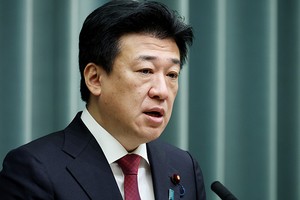By CHIHAYA INAGAKI/ Staff Writer
January 8, 2025 at 17:38 JST
 Honda Motor Co. unveils the prototype of the Honda 0 Saloon, part of its electric vehicle series, at CES in Las Vegas on Jan. 7. (Chihaya Inagaki)
Honda Motor Co. unveils the prototype of the Honda 0 Saloon, part of its electric vehicle series, at CES in Las Vegas on Jan. 7. (Chihaya Inagaki)
Honda Motor Co. unveiled two prototypes from its Honda 0 Series of electric vehicles (EV) and the self-driving technology behind them on the opening day of the annual CES trade exhibition in Las Vegas on Jan. 7.
It previously showed off earlier models of its flagship Honda 0 Saloon and Honda 0 SUV at CES 2024, with this year's iterations being closer to the final product.
Both are scheduled for release in 2026 and are part of the company's plan to focus on EVs despite their slow growth in the current market.
The automaker also aims to gain an edge with its internally developed Asimo OS (operating system) to be installed in both vehicles and advance it further in collaboration with a domestic semiconductor producer.
THE RETURN OF ASIMO
Asimo was originally a humanoid robot unveiled in 2000 that garnered global attention for Honda.
Honda continued to improve Asimo's technology that can recognize the world around it and act based on a person's intentions even after it shuttered development of the robot.
Asimo's name and tech have now been repurposed into an EV operating system. The Asimo OS combines artificial intelligence with "Level 3" autonomous driving, complete with software updates and a variety of entertainment features that can be toggled through like a smartphone.
SAE International splits self-driving technology into levels zero to five. At Level 3, a vehicle can perform all operations except for in emergencies when the driver must take control of the steering wheel.
Aside from that, drivers are free to take their hands off the wheel and use their smartphone or watch TV. This level of automated driving technology went into practical use for the first time in 2021.
Through software updates, the company plans to use AI to expand beyond the current ability to turn on the self-driving feature in highway traffic jams to all speeds. Honda said that this technology will enable things that were not possible before, such as watching movies and remote conferencing.
SUM OF ITS PARTS
To realize such technology, the structure of the car will employ integrated control by electronic control units (ECUs), which has been adopted by Tesla and other companies.
Until now, Honda’s vehicles have been controlled by separate ECUs for each function. The 0 Series integrates functions into three ECUs, which makes it possible to control driving and other operations as determined by the driver. The ECUs incorporate AI to learn and constantly evolve.
The company wants to eventually consolidate even more and integrate all functions into a single ECU for models launching in the late 2020s and beyond.
To achieve this, Honda is teaming with Japanese semiconductor giant Renesas Electronics Corp. to develop the high-performance semiconductors needed.
It will also utilize the production technology of Taiwan Semiconductor Manufacturing Co. (TSMC), another major semiconductor producer, as Honda tries for a comeback in the world of software led by U.S.-based Tesla and Chinese companies.
Honda's long-term goal is for all of its new models to be EVs and fuel cell vehicles (FCVs) globally by 2040. Tesla and China’s BYD are currently outselling Japanese carmakers in this market.
In addition, Honda's EV sales are in the bottom half of Japanese carmakers. With much at stake, the 0 Series may be the undertaking that determines Honda’s fate.
For now, the automaker plans to launch the Honda 0 SUV during the first half of 2026 and the Honda 0 Saloon later that year in the North American region. A global release that includes Japan and Europe is scheduled to follow.




















A peek through the music industry’s curtain at the producers who harnessed social media to help their idols go global.
A series based on diplomatic documents declassified by Japan’s Foreign Ministry
Here is a collection of first-hand accounts by “hibakusha” atomic bomb survivors.
Cooking experts, chefs and others involved in the field of food introduce their special recipes intertwined with their paths in life.
A series about Japanese-Americans and their memories of World War II